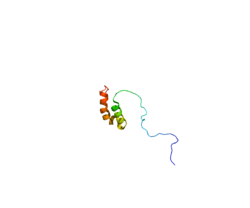COX17
Cytochrome c oxidase copper chaperone is a protein that in humans is encoded by the COX17 gene.[3][4]
Function
Cytochrome c oxidase (COX), the terminal component of the mitochondrial respiratory chain, catalyzes the electron transfer from reduced cytochrome c to oxygen. This component is a heteromeric complex consisting of 3 catalytic subunits encoded by mitochondrial genes and multiple structural subunits encoded by nuclear genes. The mitochondrially-encoded subunits function in electron transfer, and the nuclear-encoded subunits may function in the regulation and assembly of the complex. This nuclear gene encodes a protein which is not a structural subunit, but may be involved in the recruitment of copper to mitochondria for incorporation into the COX apoenzyme. This protein shares 92% amino acid sequence identity with mouse and rat Cox17 proteins. This gene is no longer considered to be a candidate gene for COX deficiency. A pseudogene COX17P has been found on chromosome 13.[4]
References
Further reading
- Punter FA, Adams DL, Glerum DM (2000). "Characterization and localization of human COX17, a gene involved in mitochondrial copper transport.". Hum. Genet. 107 (1): 69–74. doi:10.1007/s004390050013. PMID 10982038.
- Horvath R, Lochmüller H, Stucka R, et al. (2000). "Characterization of human SCO1 and COX17 genes in mitochondrial cytochrome-c-oxidase deficiency". Biochem. Biophys. Res. Commun. 276 (2): 530–3. doi:10.1006/bbrc.2000.3495. PMID 11027508.
- Kako K, Tsumori K, Ohmasa Y, et al. (2000). "The expression of Cox17p in rodent tissues and cells". Eur. J. Biochem. 267 (22): 6699–707. doi:10.1046/j.1432-1327.2000.01771.x. PMID 11054125.
- Heaton DN, George GN, Garrison G, Winge DR (2001). "The mitochondrial copper metallochaperone Cox17 exists as an oligomeric, polycopper complex". Biochemistry. 40 (3): 743–51. doi:10.1021/bi002315x. PMID 11170391.
- Strausberg RL, Feingold EA, Grouse LH, et al. (2003). "Generation and initial analysis of more than 15,000 full-length human and mouse cDNA sequences". Proc. Natl. Acad. Sci. U.S.A. 99 (26): 16899–903. doi:10.1073/pnas.242603899. PMC 139241
 . PMID 12477932.
. PMID 12477932.
- Suzuki C, Daigo Y, Kikuchi T, et al. (2004). "Identification of COX17 as a therapeutic target for non-small cell lung cancer". Cancer Res. 63 (21): 7038–41. PMID 14612491.
- Ota T, Suzuki Y, Nishikawa T, et al. (2004). "Complete sequencing and characterization of 21,243 full-length human cDNAs". Nat. Genet. 36 (1): 40–5. doi:10.1038/ng1285. PMID 14702039.
- Gerhard DS, Wagner L, Feingold EA, et al. (2004). "The status, quality, and expansion of the NIH full-length cDNA project: the Mammalian Gene Collection (MGC)". Genome Res. 14 (10B): 2121–7. doi:10.1101/gr.2596504. PMC 528928
 . PMID 15489334.
. PMID 15489334.
- Kako K, Takehara A, Arai H, et al. (2005). "A selective requirement for copper-dependent activation of cytochrome c oxidase by Cox17p". Biochem. Biophys. Res. Commun. 324 (4): 1379–85. doi:10.1016/j.bbrc.2004.09.211. PMID 15504366.
- Arnesano F, Balatri E, Banci L, et al. (2005). "Folding studies of Cox17 reveal an important interplay of cysteine oxidation and copper binding". Structure. 13 (5): 713–22. doi:10.1016/j.str.2005.02.015. PMID 15893662.
- Stelzl U, Worm U, Lalowski M, et al. (2005). "A human protein-protein interaction network: a resource for annotating the proteome". Cell. 122 (6): 957–68. doi:10.1016/j.cell.2005.08.029. PMID 16169070.
- Rual JF, Venkatesan K, Hao T, et al. (2005). "Towards a proteome-scale map of the human protein-protein interaction network". Nature. 437 (7062): 1173–8. doi:10.1038/nature04209. PMID 16189514.
- Cobine PA, Pierrel F, Leary SC, et al. (2006). "The P174L mutation in human Sco1 severely compromises Cox17-dependent metallation but does not impair copper binding". J. Biol. Chem. 281 (18): 12270–6. doi:10.1074/jbc.M600496200. PMID 16520371.
- Ma J, Dempsey AA, Stamatiou D, et al. (2007). "Identifying leukocyte gene expression patterns associated with plasma lipid levels in human subjects". Atherosclerosis. 191 (1): 63–72. doi:10.1016/j.atherosclerosis.2006.05.032. PMID 16806233.
- Voronova A, Kazantseva J, Tuuling M, et al. (2007). "Cox17, a copper chaperone for cytochrome c oxidase: expression, purification, and formation of mixed disulphide adducts with thiol reagents". Protein Expr. Purif. 53 (1): 138–44. doi:10.1016/j.pep.2006.11.014. PMID 17208454.
- Voronova A, Meyer-Klaucke W, Meyer T, et al. (2007). "Oxidative switches in functioning of mammalian copper chaperone Cox17". Biochem. J. 408 (1): 139–48. doi:10.1042/BJ20070804. PMC 2049083
 . PMID 17672825.
. PMID 17672825.
External links


 . PMID 12477932.
. PMID 12477932. . PMID 15489334.
. PMID 15489334. . PMID 17672825.
. PMID 17672825.